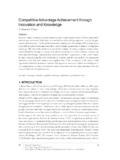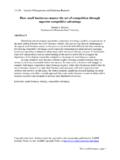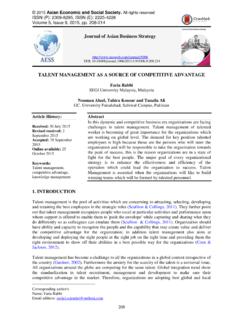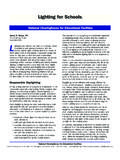Transcription of COMPETITIVE ADVANTAGE IN THE PUBLIC SECTOR
1 60 Popa I., Dobrin C., Popescu D. and Draghici M. COMPETITIVE ADVANTAGE IN THE PUBLIC SECTOR Theoretical and Empirical Researches in Urban Management Volume 6 Issue 4 / November 2011 COMPETITIVE ADVANTAGE IN THE PUBLIC SECTOR Ion POPA Academy of Economic Studies, Piata Romana 6, Bucharest, Romania Cosmin DOBRIN Academy of Economic Studies, Piata Romana 6, Bucharest, Romania Doina POPESCU Academy of Economic Studies, Piata Romana 6, Bucharest, Romania Mircea DRAGHICI Academy of Economic Studies, Piata Romana 6, Bucharest, Romania Abstract COMPETITIVE ADVANTAGE .
2 The invisible component of the strategy, has as its subbordinates visible components of the strategy (mission, objectives, strategic options, resources, time) According to the renowned specialist Michael Porter, a company s COMPETITIVE ADVANTAGE , in essence, implies ensuring a reduced cost or a product or service, that differentiates itstelf through its qualities from other products offered by others or by most competitiors. The action which doesn t lead to one of the advantages above is not of strategic interest, because COMPETITIVE fight was and is defined as the battle for COMPETITIVE ADVANTAGE .
3 Keywords: PUBLIC SECTOR , COMPETITIVE ADVANTAGE , PUBLIC SECTOR , value chain. 1. COMPETITIVE ADVANTAGE DEFINITION AND CHARACTERISTICS According to those who are studying strategy, the eternal battle of competition in any domain or industry is the confrontation for benefits. The purpose of strategy is to create and maintain strategic ADVANTAGE . For this, the strategy of the organization has to be focused on creating new advantages that will lead to increased customer satisfaction and asymmetry compared to that of the competitors. By doing so, the held ADVANTAGE may extend, while also diminishing or eliminating the advantages of the competitors.
4 In its turn, the ADVANTAGE can be achieved by various combinations. Popa I., Dobrin C., Popescu D. and Draghici M. COMPETITIVE ADVANTAGE IN THE PUBLIC SECTOR 61 Theoretical and Empirical Researches in Urban Management Volume 6 Issue 4 / November 2011 Generally, a company has COMPETITIVE ADVANTAGE when it can create more economic value than other rival companies. Economic value is the difference between perceived benefits gained by a buyer who purchases goods or services of a company and the economic cost of these products and services.
5 Therefore, the size of a company s COMPETITIVE ADVANTAGE is the difference between the economic value that the company makes and that of its rivals. (Barney and Hesterly, 2006,) The sources of COMPETITIVE ADVANTAGE of an organization lie in: Availability of quantity/quality superior financial, physical and human resources; Possession of superior technical, economic, organizational and managerial skills; Occupying a superior position on the market. Advantages produced by the two first types of sources are easy to understand, being reflexes of a bsiness capacity to achieve on a large sclae or in conditions of superiro efficienct compared with similar businesses by competing organizations.
6 COMPETITIVE ADVANTAGE offered by the third source, once acquired, can be relatively easy to defend given that revenues are sufficient to guarantee its maintenance. The advantages that result from the occupation of a superior position on the market are of several types. The most common COMPETITIVE ADVANTAGE is the one determined by the size of the organization or ots business scale. The explanation is the following: as the scale of its activities expands, the organization is capable to reduce marginal and total costsfor each additional product unit, as a result of the effects of the learning curve; earnings thus obtained can ensure profitability or can be invested in activities and directions that support the position gained, for example, intensification of R&D, internationalization of business, initiation of extensive advertising campaigns, etc.
7 It is to be pointed out that under this type of positional ADVANTAGE , organizational policies designed to ensure improvement and maintenance of the superior sposition obtained does not require special skills, superiro to the existent ones from other organizations, but that are simply more effective because of the superior position itself. Another type of COMPETITIVE ADVANTAGE is the one that results from a successful brand. They offer reliable guarantees in terms of high quality products and services, great reliability, availability in many points of sale, etc.
8 , reason why they are used with ability by the retail vendors that significiantly increase their sales volume by selling products that bear the prestigious brand. COMPETITIVE ADVANTAGE based on brand creates serious entry barriers for potential new competitors, makes it easier for organizations that 62 Popa I., Dobrin C., Popescu D. and Draghici M. COMPETITIVE ADVANTAGE IN THE PUBLIC SECTOR Theoretical and Empirical Researches in Urban Management Volume 6 Issue 4 / November 2011 have the problem with building a wide range distribution network and that rely on favorable assessment of the buyers in regards to the quality of the products bearing thebrands of the organization.
9 COMPETITIVE ADVANTAGE can be obtained only if a business system creates superior value for buyers. A company must be able to provide a more suitable product/service for customers than those produced by rival companies. Second, a successful company must also have the ability to develop and provide a superior offer of products. The activities that bring value, such as R & D (Resources and Development), manufacturing, logistics, marketing and sales are generically called chain of values (De Wit and Meyer, 2004). As far as the definition of COMPETITIVE ADVANTAGE , most definitions focus on the creation of value.
10 Although Michael Porter doesn t give a precise definition of COMPETITIVE ADVANTAGE , he says that it is the central element to a company s performance on COMPETITIVE markets, and in order to obtain it, the company can use one of the following strategic alternatives, called generic COMPETITIVE strategies: cost supremacy, differentiation and focus. Hoffman and Rumelt (2000,2003) did a review of the most important definitions over time: Introduces the idea of chain of value as a tool for analyzing the sources of strategic COMPETITIVE ADVANTAGE (Porter, 1985) Potential sources of ADVANTAGE are the superior skills and superior resources.






